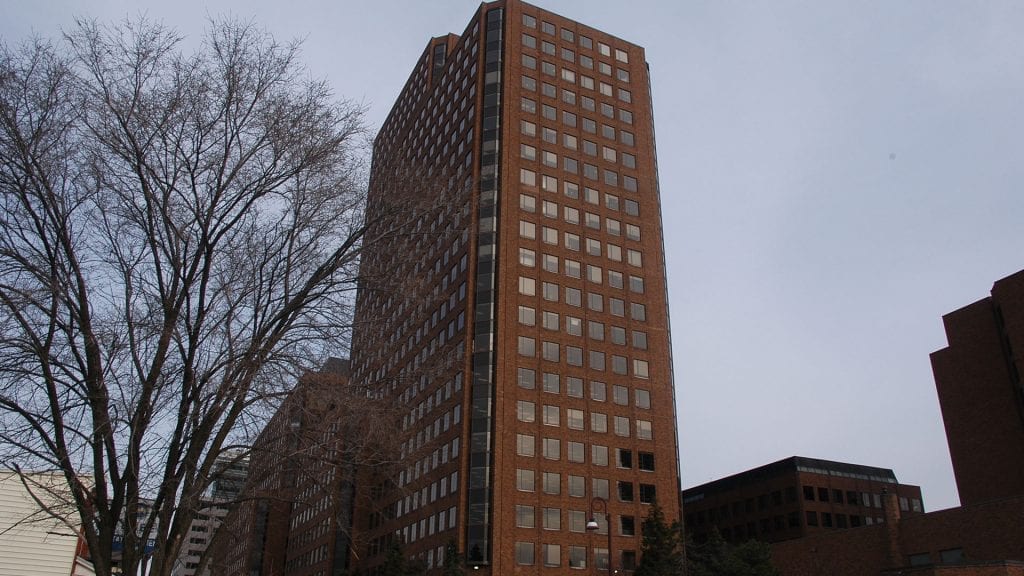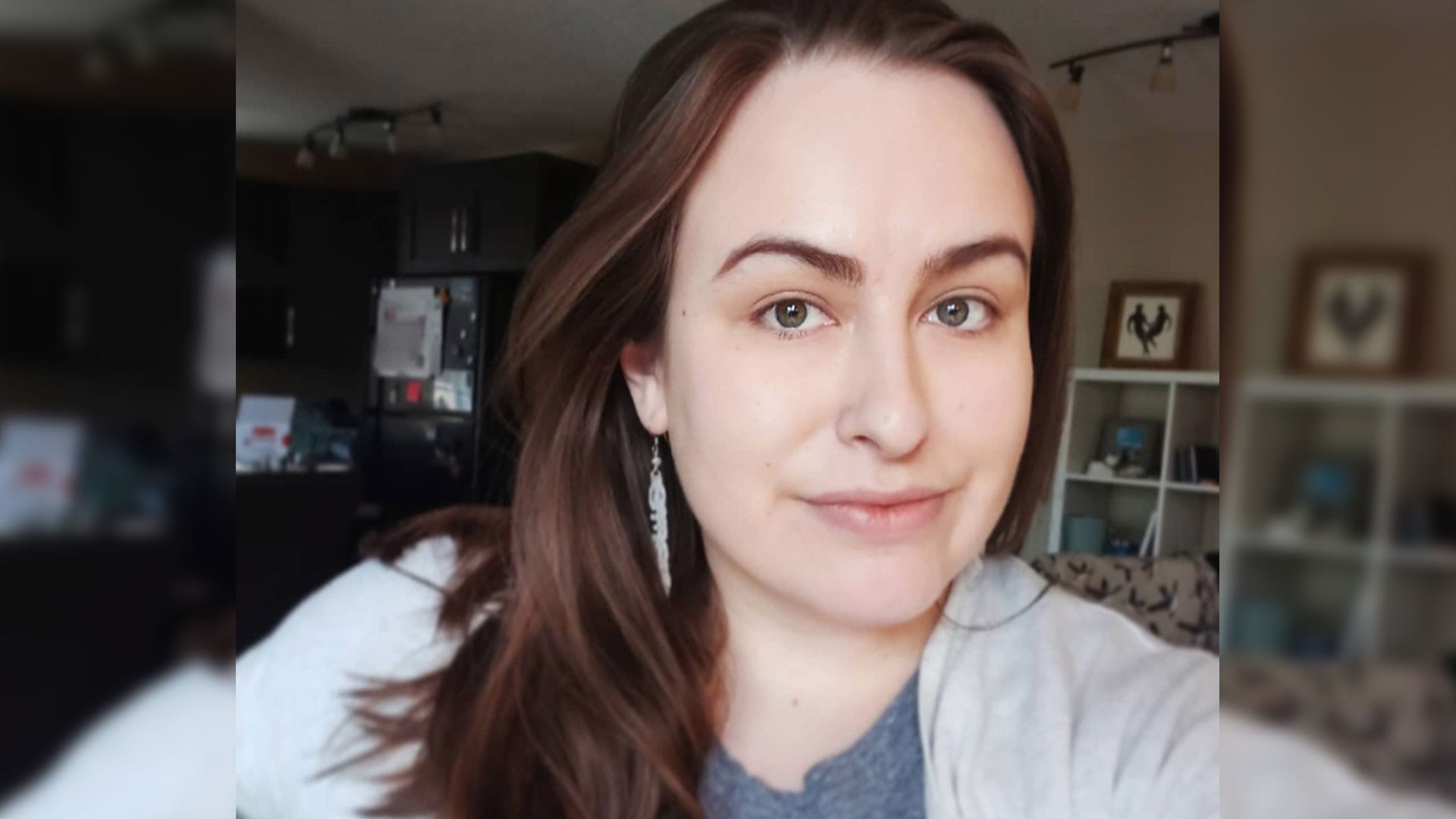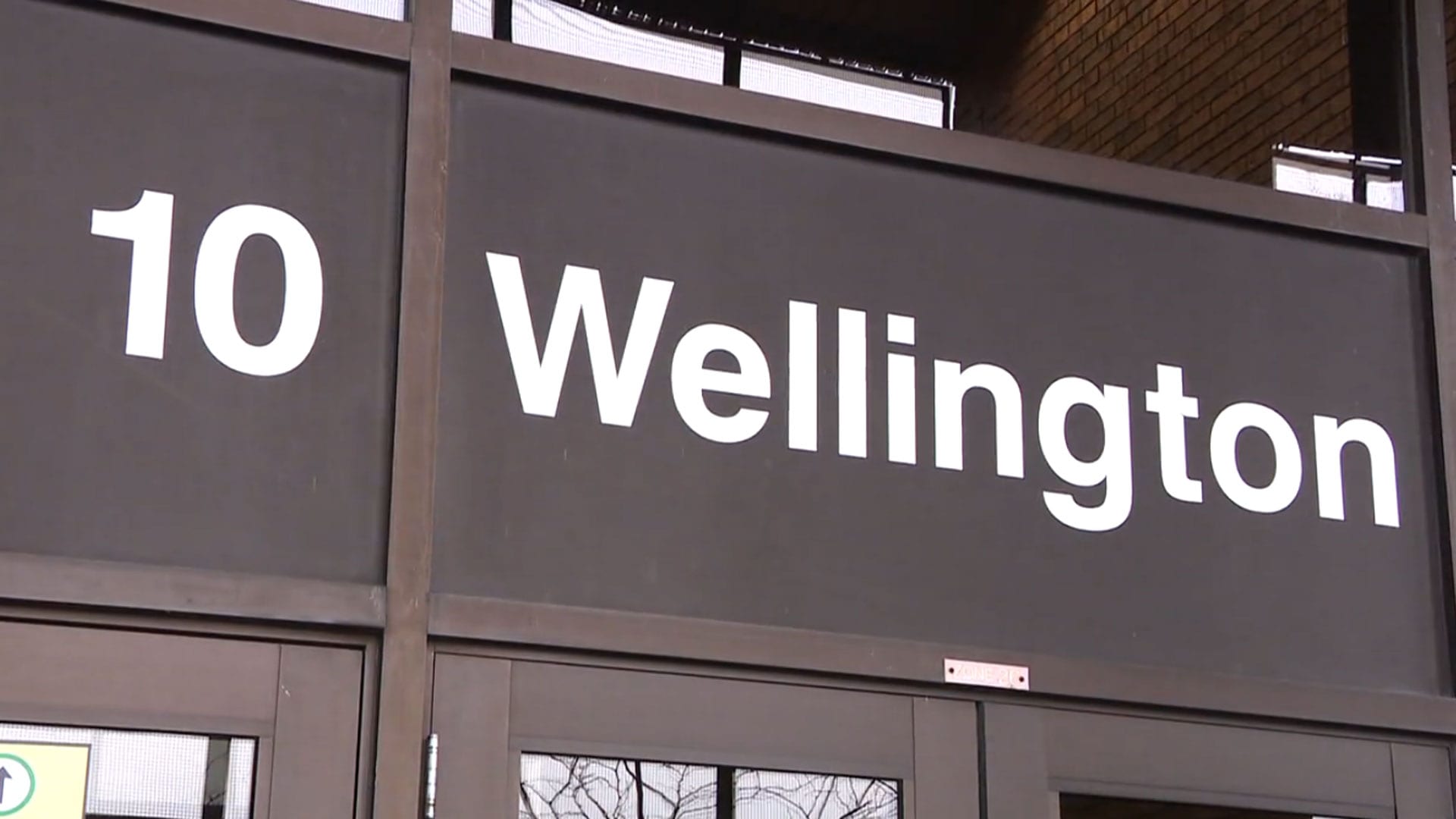
The headquarters of Indigenous Services and Crown-Indigenous Relations sits across the Ottawa River from Parliament Hill. Photo: Brett Forester/APTN
The gaslighting and casual racism of Karin Moen’s workplace had become so distressing that she thought about killing herself in her building lobby at 10 Wellington Street in Gatineau, Que.
These thoughts followed her like a shadow for 18 months. After she typed up a suicide note on her desktop computer, Moen realized she needed help.
“That day I went to the doctor. I went on stress leave for two or three weeks and then came back. A few months later, I left the department altogether,” she said, adding that she still has the letter. “I don’t know why I kept it — but I kept it. I was reading through it the other day.”
She found it hard to read. A pattern of bullying, institutional gaslighting and systemic racism had led to anger, frustration and confusion. These emotions quietly gnawed away at her confidence and sense of self-worth.
“I knew that what was happening was wrong. I also at the same time thought, well maybe I’m wrong. Maybe I’m the problem. I’m obviously the problem. No one else here is experiencing this and it’s just me,” she explained.
“That’s kind of how the suicidal thoughts come into it. Because when you’re being made to believe that you’re the problem, then the obvious solution is to remove the problem.”
Moen is Métis from Alberta and worked for what was then known as Indigenous Affairs. She is the second person who told APTN News they considered ending their life in the building lobby.

“It’s incredibly toxic,” she said. “There’s lots of anti-Indigenous racism and lots of harm that continues to be perpetuated against Indigenous communities.”
Moen remembers being told to call up communities Ottawa had funded and ask them about unspent cash because, if they had this money laying around, the director might lose his bonus.
She recalls being told to write a letter to a First Nations leader who asked about resources for treaty education. When Moen responded honestly that they were slim, she says she was told to rewrite it and, this time, massage the message to make the government look good, even if it veered away from the truth.
After a First Nations leader had to duck out of a meeting with the minister, she says, a senior manager made a snide comment about “how he was probably betting on a horse race that was more important than meeting with the minister.”
She says this sort of thing happened often. She would start to question whether the comment was racist or not. Maybe you’re overreacting, she’d think. Everyone else laughed, after all. But not you.
It was a seed of self-doubt that grew slowly over time.
“It all adds up to a bigger picture of real disdain for Indigenous people. A perception of settler superiority and white saviourism is very deeply ingrained into the department,” said Moen. “It’s just everyday there will be comments. And they can be small, but they add up to a serious impact, I think, on Indigenous people.”
She says leaving the department saved her life, though she still struggles with a host of complex emotions and uses therapy to work through them. She gets anxious walking by the building or asking for time off at her new job.
And then there’s the guilt — irrational, maybe. But no less real. A little voice still haunts her. You went to this place to help people, to change things from the inside, it says. Couldn’t you have been stronger?
“But leaving the department was the only decision I could’ve made,” she explained. “I don’t know where I would be today. I don’t know what would’ve happened if I would’ve stayed, because I was very sick working there, mentally and physically.”
Moen is also an artist. While still a public servant, she worked on the Reconciliation report for the Canada Beyond 150 project. It aimed to spark a “culture shift” across the public service.
She depicted something called “the poisoned tree” for the project. It’s a metaphor for reconciling, reforming and decolonizing Canadian society.
“We keep putting new branches on a poisoned tree, expecting that they can flourish. They can’t,” said the report. “So the question is: how do we plant a new tree?”
Colonial, paternalistic and racist ideologies are the tree’s roots, according to the teaching.
Modern institutions are the trunk.
And this?
Stories like these would have to be the fruit — the fruit of a poisoned tree.
Top civil servants and their political bosses aren’t ready to hear the truth about anti-Indigenous racism in the federal bureaucracy, according to a two-time staffer turned anti-racism facilitator.
Victoria Tenasco is Algonquin Anishinaabe from Kitigan Zibi in Quebec, about an hour north of Ottawa. She appeared in the APTN story Death by Thousand Cuts under the alias “Emily,” where she described working at Indian Affairs as “the worst experience of my life.”
She attended the emergency meetings on racism in health care convened by ministers Marc Miller and Carolyn Bennett following the death of Joyce Echaquan.
Tenasco says it’s critical these stories see the light, which is why she’s speaking out even though she fears it may be career limiting.
“There needs to be an inquiry, and they need to hear from people who’ve worked in their departments,” she said. “For four hours, they listened to Indigenous Peoples talk about their harrowing experiences in the health-care system. I want them to sit there for four hours and hear from people like me.”
Tenasco said she was shocked to learn how bad it was for some employees. And yet her story was strikingly similar.
She describes a familiar pattern of systemic racism and institutional gaslighting that led to fear, anxiety and frustration. These emotions turned to confusion and self-doubt until they became too much to bear.

She remembers being whisked up to Kitigan Zibi to shoot a scripted promotional video to help with recruitment. She describes the experience as tokenizing and dehumanizing because, back at the office, she was feeling increasingly marginalized and distressed.
One Sunday evening, as she gathered up her things preparing to head back to Ottawa, she suddenly broke down and cried.
“I got a doctor’s letter. Eventually I was off work for a year, and I felt like a huge idiot because I was so young,” Tenasco said. “It made me feel like I had this great opportunity and I was f—ing it up. And it’s just insane how deeply this hurts people.”
She walked away. But a gnawing sense of guilt haunted her. It was that same little voice saying maybe it was your fault, not theirs. You came here to make change for your people. Couldn’t you just push through?
“I lived with that guilt for a really, really long time until I started learning more about cultural safety, anti-racism and colonial oppression,” she said. “I couldn’t even pass by the building at 10 Wellington. I couldn’t even go inside.”
Even so, she returned to the department, now known as Indigenous Services Canada, years later. She hoped things changed.
Tenasco administered capacity building programs designed to fast-track Indigenous bureaucrats into managerial roles. She quickly became concerned about ethnic fraud.
She alleges non-Indigenous people frequently and brazenly took advantage of the Public Service Commission’s policy that allows people to self-identify.
For Tenasco, the double standard and hypocrisy were clear. Indigenous Services administers the Indian Act. The department regulates identity and demands proof to access federal cash and programs.
“You cannot self-identify and get your glasses paid or get your dental appointment paid. You need a status card,” she said.
She remembers asking someone she knew was not Indigenous why they applied.
“The person said, ‘Well, it’s faster, so I just put my name in because you’re not allowed to ask me to prove my identity.’ We were dumbfounded,” Tenasco said. “White people know that that’s an in.”
The situation was even more frustrating, she explains, because she was hired via temporary contract. When the contract ran out — due to the pandemic and lack of permanent roles — Tenasco wasn’t renewed.
As a temporary worker, she wasn’t even eligible for these capacity building programs even though she ran them.
It left her again dismayed, sensing the palpable hypocrisy.
Treasury Board ‘does not compile’ data on deaths by suicide
The Public Service Commission confirmed it relies on something called the Affirmation of Aboriginal Affiliation Form, or AAAF, to determine Indigenous identity for hiring purposes within government.
It’s a one-page “solemn acknowledgement” of one’s identity — but one that doesn’t require proof. “In the event of an investigation,” someone accused of making a fraudulent declaration of identity would have to “substantiate the information provided,” the commission wrote in a statement.
So what if someone does lie?
The commission said it has the authority to investigate fraud, explaining allegations must be made in writing and accompanied by supporting documents. If proven true, the person’s appointment could be revoked. But this doesn’t seem to extend to lying about identity.
“In an alleged false claim of Aboriginal affiliation, it is important to note that the PSC does not have the mandate or authority to validate the person’s Aboriginal affiliation,” the commission said, “but will examine whether the person knowingly provided false information to gain an advantage in the appointment process.”
The organization added that it is “currently reviewing” this form’s usefulness and expects to complete this review by the end of 2021.

APTN also asked the Treasury Board Secretariat to provide statistics on death by suicide within the public service — specifically, the number of employees who killed themselves while working for the federal government over the last five years.
The department responded with a long statement outlining the mental health support available to employees.
“The public service has long made diversity and inclusion a core value and continuously reflects on the treatment of Black Canadians, Indigenous Peoples, and other individuals who face racial discrimination and other barriers in the workplace, and who are often underrepresented at the most senior levels of the public service,” it read.
But the secretariat replied that it either doesn’t know or can’t say how many of its employees have ended their own lives.
“Cause of death is considered personal information under the Privacy Act,” said the statement. “As a result, the Treasury Board of Canada Secretariat does not compile this information and cannot answer your specific questions on this subject.”
Three more First Nations women who presently work for Indigenous Services say they experience the same cycle that seems to persist across different times, branches and regions.
APTN agreed not to identify them because they fear they’ll be fired or disciplined.
“Working in that environment has placed a negative impact on our mental health. We’ve all experienced it in different ways,” said an employee we’ll call Ashley.
She too had to resort to stress leave and therapy. She ultimately left to a different sector within the department to get away from what she calls a “really toxic” work environment.
“It was really starting to impact how I did my work. I had no motivation,” Ashley explained. “I didn’t want to interact with my colleagues because I was just so angry at the fact that they’re OK with how things were going.”
Another long-time staffer describes it as a stranglehold of manipulation, fear and obedience.
“That’s basically how the noose of silence works. It’s like you cannot speak for your rights. If you do, you’re going to get a nasty long email, and they’ll basically use psychological abuse to try and convince you that you did something wrong,” said an employee we’ll call Mary.
“That’s the chokehold that they use to retaliate against anybody and everybody.”
But there’s another aspect, she added. Mary believes the systemic racism at the top flows downstream and can harm communities.
For instance, recent Yellowhead Institute research found significant regional discrepancies in denial rates for Jordan’s Principle funding requests.
These denial rates fluctuate significantly from province to province, revealing “how much influence regional decision makers have over how Jordan’s Principle is applied and interpreted,” the research found.
Mary and others allege that those same managers who engage in casual racism or lack adequate cultural sensitivity are often the ones approving or denying these requests.
“This racism that everyone’s identifying, it’s impacting the employees, but there’s also points where a lot of it is negatively impacting the First Nations as a whole and how their services get adjudicated,” explained Mary.
“We the employees are suffering. But also, so are the children.”
Ministers Marc Miller, Carolyn Bennett and Dan Vandal sent APTN a statement about this last month.
“We are deeply disturbed by the incidents reported in the media and are working with Deputy Minister (Christiane) Fox and Deputy Minister (Daniel) Quan-Watson to conduct a thorough review to address this matter,” said the statement.
“Action will be taken to ensure Indigenous employees are treated with the dignity and respect they deserve. We recognize that we must achieve the highest standards as we expect all Canadian institutions to eliminate racism and discrimination in all its forms.”
But, having been through all this, our sources weren’t convinced. They described the response as “lip service” several different times.
“I have absolutely no faith that any sort of investigation would be done in good faith, and that it would result in any sort of change,” said Moen. “From 2015 they’ve known this was an issue, and they’ve done absolutely nothing.”
Tenasco offered a similar take. Bureaucrats reviewing their own department would be like “cops investigating cops,” she said. “This doesn’t work.”
Instead, she explained, Indigenous people themselves ought to be leading this review. She doesn’t believe the government is prepared to hear these stories because it would require serious accountability.
“I don’t think they’re ready to accept responsibility that it’s that bad,” she said. “For us, it’s personal. It’s personal work. Even to the Indigenous person who pushes finance papers all day at INAC, it’s still personal because they’re working for the department that services your people.”
Tenasco was also the second source who suggested an external public inquiry might be necessary.
The other person was Letitia Wells, a former employee turned academic who told APTN her workplace was “so poisonous” people contemplated suicide there as well.
But there’s no need to hold another inquiry, said Wells, adding there are enough reports on shelves, enough recommendations already out there.
She and many other employees noted that waves of people coming forward are forcing other public institutions to reckon with racism, bullying and misogyny that have festered in shadows of obedience and silence for decades.
“To the Indigenous women out there, to the Indigenous employees, the only way this is going to stop is if you step up and tell your stories,” said Wells.
“I think the only way this is going to change is if a class-action lawsuit starts against them, because they’re not hearing us. They’re retaliating against us.”
Black public servants sued the Treasury Board for $900 million last year, alleging systemic discrimination spanning decandes.
Tenasco took a moment to think when asked if Indigenous employees might consider something similar.
“I would really love to see that happen, yeah,” she remarked. “It’s a way for them to actually have to be responsible.”
The Canada Suicide Prevention Service enables callers anywhere in Canada to access crisis support using the technology of their choice (phone, text or chat), in French or English:
Phone: toll-free 1-833-456-4566
Text: 45645
Chat: crisisservicescanada.ca









